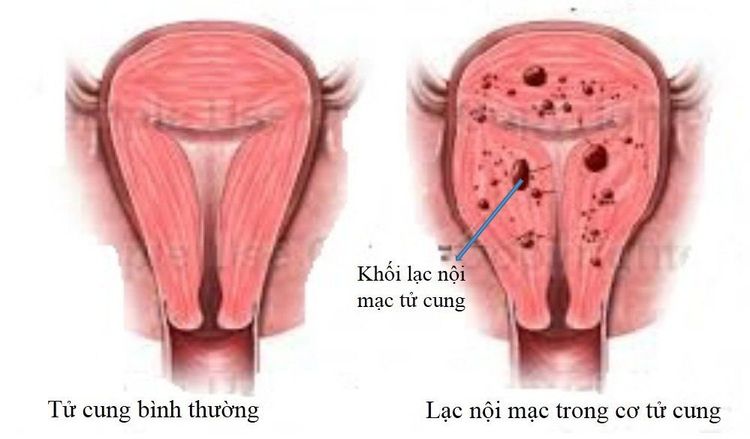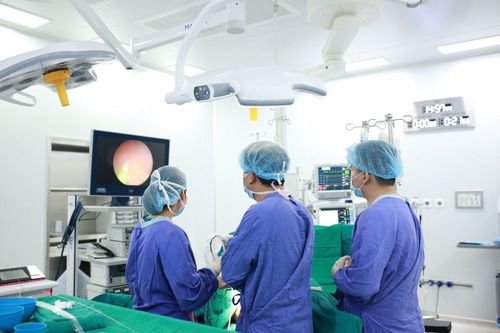This is an automatically translated article.
The article was professionally consulted with Specialist Doctor II Tran Thi Mai Huong - Obstetrician and Gynecologist - Department of Obstetrics and Gynecology - Vinmec Hai Phong International General Hospital.Endometriosis usually occurs in women of reproductive age. The disease is not only painful but also seriously affects a woman's fertility, if not treated early, it can lead to infertility.
1. What is endometriosis?
Endometriosis is one of the most common diseases in women. It occurs when the cells of the endometrium exit the uterus and grow on other organs such as the ovaries, the outer wall of the uterus, the fallopian tubes, the ligaments that support the uterus, the rectum, and the uterus. bladder. In rare cases, they can spread beyond the abdomen and grow on other organs, such as the lungs.Like normal uterine tissue, these abnormal growths also shed and cause bleeding during the menstrual cycle. However, because they escape and grow in other tissues, blood cannot flow out of the body but back in. This has caused irritation to the surrounding tissues, creating adhesions, scarring, and fusion of body tissues. Over time, it can lead to infertility.

2. Risk factors for endometriosis
Currently, medicine has not made an exact conclusion about the cause of endometriosis in women. However, we can consider a few factors below:Reflux of menstruation: This is probably the most common cause of endometriosis. A woman's menstrual blood contains endometrial cells, which instead of going out of the body during menstruation, tend to flow back in through the fallopian tubes into the pelvic cavity. Once there, these "stray" cells will stick to the pelvic walls and surfaces of the pelvic organs, continuing to function like other normal uterine tissue (thickening and causing menstrual bleeding). moon).
Embryonic cell transformation: The growth and transformation of embryonic cells stimulates the growth and formation of cells lining the abdominal cavity and pelvic area, which in turn leads to endometriosis. .
Scars from surgery: Scars left after surgery, such as a cesarean section or hysterectomy can cause endometrial cells to adhere to the incision and lead to a condition Endometrial optimism.
Displacement of endometrial cells: This is also considered another cause of endometriosis. Displacement of endometrial cells occurs when they are carried by tissues or blood vessels to other organs in the body.
Immune system problems: Endometriosis can occur when the body's immune system is having certain problems. This limits the body's ability to recognize and eliminate growing tissue outside the uterus.
Genetic predisposition: Several studies have shown that endometriosis tends to run in families. If you have a close relative (grandmother, mother, aunt, sister, or brother) with endometriosis, there is a high risk that you will also have it. What's more, endometrial cells may have already formed outside the uterus while you were still in the womb.
Some other risk factors: Here are some factors that can increase a woman's risk of endometriosis:
Have a history of pelvic inflammatory disease Never have had a baby Have a period before 12 Age Uterus or vagina irregular shape Due to industrial chemicals Dioxin.
3. Common symptoms of endometriosis
When you have endometriosis, you may experience the following symptoms:Abdominal pain Low back pain Pelvic pain that persists during menstruation Pain after having a bowel movement or urinating during menstruation Pain during or after sex Pain that is severe during menstruation, can be pain before or during menstruation. Irregular menstrual cycle Blood in stools and urine Vaginal bleeding after sex Fatigue Body Constipation, diarrhea, bloating and nausea during menstruation Infertility When symptoms appear Above, you should see your doctor for timely diagnosis and treatment before they cause other serious complications.

4. Measures to help control endometriosis
Knowing the causes and risks of endometriosis, you can take the following measures to effectively control the symptoms of the disease:Regular exercise or yoga Bath with warm water or compresses Heat to relieve pain caused by spasms of pelvic muscles Should put a pillow under the knees when lying down Follow a reasonable diet: eat lots of green vegetables, white meats like pork, chicken or fish ; Avoid greasy or fried foods. Drink plenty of water See more biofeedback therapies or try some other body relaxation techniques. In order to help customers detect and treat gynecological diseases early, Vinmec International Hospital has a basic gynecological examination and screening package, helping customers detect early infectious diseases and help treat easy, inexpensive. Screening detects gynecological cancer (cervical cancer) early even when there are no symptoms.
Basic gynecological examination and screening package for female customers, has no age limit and may have the following symptoms:
Abnormal vaginal bleeding Having menstrual problems: irregular menstrual cycle, irregular menstrual cycle Irregular vaginal discharge (smell, different color) Vaginal pain and itching Female clients have several risk factors such as poor personal hygiene, Unsafe sex, abortion,... Female customers have other symptoms such as: Abnormal vaginal discharge, itching, pain in the private area, abnormal vaginal bleeding.
Please dial HOTLINE for more information or register for an appointment HERE. Download MyVinmec app to make appointments faster and to manage your bookings easily.
Reference source: Webm.com













